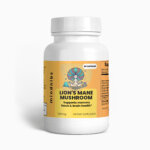
“Seasonal Growth: When Do Lion’s Mane Mushrooms Grow?”
Imagine a forest where whispers of ancient wisdom echo through the trees and a delicate balance of nature’s cycles unfolds before your eyes. Here, nestled in the crooks of hardwood giants, a peculiar organism unfurls its splendor with the subtlety of the changing seasons. It’s the Lion’s Mane mushroom, a culinary and medicinal marvel that doesn’t just grow; it performs an enchanting seasonal ballet, governed by the rhythm of the earth’s tilts and turns.
In the pages that follow, we invite you on a whimsical journey through time and temperature to discover the secrets of when Lion’s Mane reaches its glorious peak. This is not merely a story of growth; it’s a tale of seasonal magic, of life’s intricate synchronicity with the calendar. Prepare to be captivated by the majestic, shaggy caps of Lion’s Mane, to understand their timely bloom, and to be persuaded that the best things in life are not just worth waiting for—they are worth timing for. into the seasonal growth of the Lion’s Mane mushrooms, and let your curiosity thrive alongside these extraordinary fungal beings.
Table of Contents
- Unlocking the Mystery of Lion’s Mane Mushroom Seasons
- Cultivating Wisdom: Understanding the Growth Cycle of Lion’s Mane
- Nature’s Calendar: Pinpointing the Peak Seasons for Lion’s Mane Harvest
- Fostering a Forest of Flavor: Tips for Growing Lion’s Mane at Home
- Harvesting Harmony: When Lion’s Mane Flourishes in the Wild
- The Indoor Advantage: Year-Round Lion’s Mane Cultivation Secrets
- Weathering the Growth: Climate’s Impact on Lion’s Mane Mushroom Cycles
- Beyond the Backyard: Finding Lion’s Mane in Their Natural Habitat
- Preserving the Pride: Storing Lion’s Mane Mushrooms for Longevity
- From Spore to Spectacle: Nurturing Each Stage of Lion’s Mane Development
- Q&A
- To Conclude
Unlocking the Mystery of Lion’s Mane Mushroom Seasons

As the seasons change, so does the landscape of the forest floor, and with it, the cycles of various fungi. Among these, the Lion’s Mane Mushroom (Hericium erinaceus), emerges as a wonder of nature, both for its unique appearance and its sought-after medicinal properties. These bearded beauties have a specific growing season, an elusive window that foragers and cultivators alike mark on their calendars with anticipation.
Traditionally, autumn ushers in the peak of Lion’s Mane proliferation. This is when the air carries a crispness, the leaves begin their colorful transformation, and the forest turns into a treasure trove for mushroom enthusiasts. But this isn’t a hard and fast rule, as the mushroom can also be found in the wild from late summer through to the depths of winter. Here’s how the seasons stack up:
- Late Summer: Though rarer, early risers can be spotted adorning hardwood trunks after substantial rainfall.
- Fall: Prime time for foraging. These mushrooms thrive in the cooler and wetter climate.
- Winter: In milder regions, the Lion’s Mane can continue to grow, especially on wounds of living trees.
- Spring: A less common season, but some years surprise us with late bloomers, especially in cooler areas.
For those looking to cultivate Lion’s Mane at home, understanding the natural cycle can be pivotal for a successful harvest. While outdoor cultivation aligns with seasonal growth, indoor cultivators can manipulate conditions to enjoy Lion’s Mane year-round. Below is a simplified table showcasing ideal conditions for cultivation:
| Season | Temperature Range | Humidity | Substrate Preference |
|---|---|---|---|
| Fall | 15 – 20°C (59 – 68°F) | High (85-90%) | Hardwood Sawdust |
| Other Seasons (Indoors) | 21 – 24°C (70 – 75°F) | Moderate (60-70%) | Supplemented Hardwood |
Unraveling the mystery of Lion’s Mane seasonality is a journey through the ebbs and flows of nature’s rhythms. By aligning our foraging and cultivation practices with these natural cycles, we secure the key to unlocking the full potential of these majestic mushrooms. Let the changing leaves and cooling breezes be your guide as you step into the woods or tend to your indoor grow, ever mindful of the perfect moment to harvest nature’s very own brain food.
Cultivating Wisdom: Understanding the Growth Cycle of Lion’s Mane

The mystical journey from spore to full bloom is a sight to behold in the world of fungi, and the Lion’s Mane mushroom is no exception. Known scientifically as Hericium erinaceus, this brain-shaped wonder is not just a culinary treat but a timekeeper of the forest, syncopating its growth to the rhythm of the seasons.
Let’s into the lifecycle. In the spring, a perfect coupling of humidity and warmth coaxes the spores of the Lion’s Mane to germinate. These conditions awaken the mycelium, the intricate, thread-like network that forms the mushroom’s vegetative body. Under the cozy shelter of hardwood trees, the mycelium patiently weaves its web, storing energy for the grand display to come.
As autumn casts a cooler blanket over the forest, the Lion’s Mane’s true spectacle begins. From late summer to early fall, the mycelium decides it’s showtime. Nutrient-rich locations along the mycelium sprout tiny, icicle-like formations. These primordia will swell, given the right conditions, into the full-bodied, cascading waterfalls of spines that are characteristic of a mature Lion’s Mane mushroom.
To capture the essence of their growing season, here’s a snapshot in table form:
| Season | Activity | Harvest Window |
|---|---|---|
| Spring | Spore germination & mycelium growth | Late Summer – Early Fall |
| Summer | Mycelium maturation & primordia formation | |
| Autumn | Fruiting & harvest peak | N/A |
| Winter | Dormancy & energy conservation | N/A |
Understanding this cycle is paramount for those wishing to forage or cultivate their own Lion’s Mane mushrooms. By mimicking nature’s timetable and providing the right environment, you too can have the pleasure of watching these wisdom-laden fungi flourish. And rest assured, nurturing these furry fruits of the forest is well worth the effort, not just for their robust flavor but for their myriad health benefits too.
Nature’s Calendar: Pinpointing the Peak Seasons for Lion’s Mane Harvest

If you’re aiming to forage or cultivate the illustrious Lion’s Mane mushroom, timing is essential. These unique fungi flourish under specific conditions, and understanding the seasonal patterns allows growers and foragers alike to harness the bountiful periods for optimal harvest.
Typically, Lion’s Mane mushrooms announce their presence in late summer and continue their growth well into the fall. The succession of warm days and cool nights offers the perfect catalyst for these fungal wonders. To seize the season, mark your calendars—the window of opportunity generally spans from August to November for those in the Northern Hemisphere, merging perfectly with the tapestry of autumnal colors.
- August to September: Begin regular forays into hardwood forests; prime growth amidst the onset of cooler evening temperatures.
- October: Peak visibility in forests as temperatures start to drop consistently.
- November: Last chance for harvest before frosts potentially inhibit growth.
For those seeking a more structured approach, consider the following harvest timetable. Bear in mind, regional climates can shift these timeframes, so it’s wise to stay attuned to local weather patterns.
| Season | Harvest Period |
| Early Season | August – Early September |
| Mid Season | September – October |
| Late Season | October - Mid November |
As you pencil in your mushroom foraging expeditions or plot the timeline for your cultivation cycles, remember that patience and observation are your best tools. Engage with a community of fellow enthusiasts to share insights and experiences—collectively, you’ll uncover the subtle cues that signal the peak moments for harvesting Lion’s Mane. With reverence for nature’s rhythms, your foraging and cultivation efforts will align harmoniously with the ebb and flow of the seasons.
Fostering a Forest of Flavor: Tips for Growing Lion’s Mane at Home

Growing your own Lion’s Mane mushrooms can transform your culinary experience and bring a touch of the wild indoors. The first step to harnessing this delectable fungi is understanding when they naturally thrive. Although commercial cultivation techniques allow Lion’s Mane to be grown year-round, they flourish particularly well during the fall months when the air is crisp and the moisture level is just right.
To ensure your mycelium takes root, keep an eye on these variables:
- Temperature: Aim for a cool environment between 65 and 75 degrees Fahrenheit.
- Humidity: Mushrooms love moisture, so target a humidity level of 85% to 95%.
- Indirect light: While Lion’s Mane doesn’t require much light, a little indirect sunlight can go a long way.
- Fresh air exchange: A steady supply of fresh air is vital for healthy growth, mimicking the breezy fall forest.
But what if you want to enjoy your homegrown Lion’s Mane outside the typical fall harvest? With a little extra care, you can cultivate a forest of flavor in any season. By managing the temperature and humidity within your growing area, you can create a micro-environment that mimics the ideal conditions for Lion’s Mane to prosper. Use a space heater or a humidifier, if needed, to maintain those optimum ranges. Be sure to monitor your setup regularly, as consistency is key.
Here’s a quick guide to your Lion’s Mane seasonal calendar:
| Season | Temperature | Humidity | Care Tips |
|---|---|---|---|
| Spring | 60-65°F | 90% | Start from spawn, increase fresh air |
| Summer | 65-75°F | 85%-95% | Watch for overheating, maintain high humidity |
| Fall | 65-75°F | 85%-95% | Ideal season, reduce intervention |
| Winter | 50-60°F | 90% | Insulate from cold, maintain steady temperature |
Remember that the secret to cultivating Lion’s Mane lies in the details. It’s all about recreating their natural growing conditions. So, roll up your sleeves, ready your green thumb—or should I say, your “mushroom thumb”—and venture into the rewarding world of homegrown fungi. Your efforts will pay off when you slice into that first savoury, meaty fruiting body, knowing you’ve nurtured it from spore to plate.
Harvesting Harmony: When Lion’s Mane Flourishes in the Wild

Imagine wandering through a dew-kissed forest at the break of dawn. The air is crisp, the birdsong a gentle chorus. Among the intertwined trunks and mossy undergrowth, a bounty of the forest gently unfurls; the Lion’s Mane mushroom. These ethereal fungi, with their cascading spines resembling a regal mane, are not only a captivating sight but also a testament to nature’s miraculous rhythms. They burst forth in their prime as summer fades, gracing the wild from late summer to early fall.
In the wild orchestra of nature’s growth, the Lion’s Mane has a solo part that captivates the foragers. Timing is pivotal; conditions must align with almost theatrical precision for this spectacle to unfurl. As the humidity whispers into the forest canopy and the temperature cools, look closely for the mushroom’s white pom-pom clusters that embellish the forest’s hardwoods. This flourishing aligns with the mushroom’s love for nourishment from the retiring trees, adding complexity and substance to the forest’s ongoing symphony.
- Bountiful forests and healing trees provide the stage
- The humidity serves as the opening act
- Temperature drops for the mushroom’s crescendo
While the Lion’s Mane prefers the autumnal encore, the specific months of peak performance can vary based on geography and climate. Here’s a snapshot of when foragers might expect these treasures to emerge:
| Region | Optimal Foraging Season |
|---|---|
| North America (Northeast) | August to November |
| Europe (Western) | September to February |
| Asia (Temperate Regions) | October to March |
Whether novice or seasoned forager, the pursuit of Lion’s Mane becomes more than a leisurely hunt—it morphs into a dance with the wild. The mushroom, with its impressive cognitive benefits and culinary versatility, beckons nature enthusiasts into the woods with a promise of both adventure and bounty. This forest-grown nootropic embodies a harmony that can only be witnessed when the wild’s timetable aligns with our own thrill for discovery.
The Indoor Advantage: Year-Round Lion’s Mane Cultivation Secrets

Unlocking the secrets of cultivating Lion’s Mane mushrooms indoors lets you sidestep the constraints of the seasons. With control over temperature, humidity, and lighting, you have the power to mimic the ideal conditions that these brain-boosting fungi crave. By keeping a close watch on their environment, you can entice Lion’s Mane to bloom even when the snow is falling outside your window, ensuring a steady supply of these delectable, health-packed morsels.
First and foremost, success hinges on maintaining a consistent temperature between 65 to 75 degrees Fahrenheit. You’ll also need to monitor the humidity closely; aim for a range of 85% to 95%. Proper air exchange is vital as well; it encourages higher yields and the development of robust, thick spines – the hallmark of a healthy Lion’s Mane harvest. Here’s a quick rundown of the environmental checklist:
- Temperature: Steady 65-75°F
- Humidity: Optimal 85-95%
- Air Exchange: Crucial for growth & health
Lighting also plays a starring role in transitioning Lion’s Mane from their vegetative state to fruiting. While these mushrooms aren’t as light-dependent as some might think, they still require a specific type of exposure to approximate the gentle sunlight filtered through a forest canopy. An arrangement of 5000k daylight LED bulbs set to a 12-hour on/off cycle will typically do the trick, nudging your indoor Lion’s Mane from mycelium to full-blown fruition.
The beauty of indoor cultivation is the precision it affords. You can harvest these culinary delights with the right timing and care. Using the table below, you can chart their growth stages and prime harvesting periods.
| Growth Stage | Duration | Visual Cue |
|---|---|---|
| Incubation | 14-21 days | White mycelial growth |
| Primordia Formation | 3-5 days | Pinhead-sized knots |
| Fruiting & Development | 7-10 days | Spine elongation |
| Harvest | 1-2 days | Large, toothy caps |
By duplicating Mother Nature’s blueprint within your own indoor grow space, you can encourage your Lion’s Mane mushrooms to prosper, yielding a harvest that any forager or gourmet would envy. This nuanced approach allows you to indulge in the unique, lobster-like flavor of Lion’s Mane all year long, without waiting for nature to set the table.
Weathering the Growth: Climate’s Impact on Lion’s Mane Mushroom Cycles

Like many living organisms, the regal Lion’s Mane mushroom, with its shaggy, white cascades, thrives according to the whims of our planet’s complex climate system. These spectacular fungi have an intimate dance with the seasons that can be as mesmerizing as it is critical for those looking to cultivate or forage them.
As spring’s gentle warmth nudges the forest floor, this is when Lion’s Mane mushrooms begin their majestic emergence. Steady temperatures ranging between 60 to 75 degrees Fahrenheit, coupled with the moisture from spring rains, set the stage for their growth. Yet, one cannot ignore the subtle variances resulting from climate change; milder winters and unpredictable weather patterns are expanding the traditional fruiting windows, allowing these mushrooms to appear even in the late throes of winter in some regions.
- Begin looking for growth in late winter to early spring
- Optimal fruiting occurs at 60-75°F with ample moisture
- Monitor local climate trends for unusual growth patterns
- Consider the impact of climate change on traditional cycles
As we traverse into the lushness of summer, the Lion’s Mane can continue to flourish, provided their preferred conditions of damp woods and reasonable temperatures persist. But beware: the unabated heat of a midsummer drought can hamper their development. Even as our environment shifts under the sun’s ardent gaze, these fungi offer a potent reminder of the importance of balanced ecosystems for their survival—and ours.
| Season | Typical Fruiting Period | Notable Conditions |
|---|---|---|
| Spring | March – June | Wet soils, moderate temps |
| Summer | June - August | Humidity, potential droughts |
| Fall | September – November | Cooling temps, seasonal rains |
The cycle of growth draws to a close with the crisp air and turning leaves of autumn. This can be a secondary surge for Lion’s Mane mushrooms, reveling in the dropping temperatures and increased precipitation. It’s a final flourish before the cold seizes the growth reins, compelling these organisms to retreat once more into the earth’s embrace, only to reawaken with the next turn of the seasons.
Beyond the Backyard: Finding Lion’s Mane in Their Natural Habitat

Venturing beyond the cozy confines of our backyards, foragers and fungi enthusiasts often find themselves entranced by the allure of the elusive Lion’s Mane mushroom in their natural settings. These majestic fungi, reminiscent of cascading white icicles, thrive most abundantly on hardwood trees in the cooler months. But, with the right knowledge and a keen eye, you might spot these bearded beauties gracing the wounds of old and dying trees.
Autumnal Abundance – As summer’s warmth gives way to crisp fall air, Lion’s Mane mushrooms begin their grand emergence. The drop in temperature and increased moisture content in the air create an idyllic stage for their growth. Forests with venerable hardwoods like beech, oak, and maple become prime real estate for these sought-after fungi. You’ll want to mark your calendar for this seasonal show; from late summer to early fall, the forest transforms into a forager’s treasure trove.
Standing beneath the forest’s canopy, not all trees are created equal in the eyes of a Lion’s Mane hunter. The best strategy is to search for trees that have begun their descent back into the earth — think snag branches and decomposing stumps. Here’s a quick checklist to guide your quest:
- Scour along the trunks of aging hardwoods
- Eye out for snag branches - perfect Lion’s Mane hosts
- Inquire amongst local foraging groups for tips on hotspots
- Check after rainfall when mushrooms are most likely to appear
For those who admire order, a simple table can help keep track of when and where you might expect to encounter these fungal wonders. Despite the unpredictable nature of foraging, patterns do emerge with careful observation:
| Season | Preferred Habitat | Tip |
|---|---|---|
| Fall | Decomposing hardwood stumps | Check after a rainfall |
| Winter | Living trees with wounds | Look for icicle-like formations |
| Early Spring | Snag branches | Be mindful of weather changes |
As we pull on our boots and step into the dappled sunlight of the woodland, the hunt for Lion’s Mane becomes more than just a search for a culinary or medicinal prize. It’s a gentle reminder of the intricate and often hidden connections within our natural world. By understanding the rhythms of seasonal growth and respecting the habitats of these incredible organisms, foragers can into an enriching experience that goes beyond the simple act of gathering – it is one of connection and wonderment with nature’s cycles.
Preserving the Pride: Storing Lion’s Mane Mushrooms for Longevity

Capturing the ethereal beauty and health benefits of lion’s mane mushrooms doesn’t have to be fleeting. With a little know-how, you can keep these treasures of nature vibrant and potent long after their peak season. Whether you’re a culinary enthusiast or seeking their medicinal prowess, smart storage is your best ally.
Dehydration: A Time-Honored Tradition
One of the most effective ways to extend the life of lion’s mane mushrooms is to dry them. Lay them out on a clean surface, slice into manageable pieces, and let them bask in a dehydrator or a warm, well-ventilated area away from direct sunlight. When they’re as crispy as autumn leaves, store them in an airtight container, and they’ll remain your faithful companions in cooking adventures for months.
- Avoid plastic bags which can trap moisture and lead to spoilage.
- Opt for glass jars with moisture-absorbing packets to combat humidity.
- Remember, rehydrated lion’s mane mushrooms can revive dishes with their original texture and flavor.
Freezing: The Modern Pause Button
If you prefer to preserve the mushroom’s texture more closely to its fresh state, freezing is your go-to option. After a quick blanching — to halt enzyme activity and preserve color — let them cool and transfer them to freezer-safe bags or containers. They’ll play hide-and-seek within your freezer, waiting to leap out and jazz up your soups, stews, and stir-fries whenever you beckon.
| Preservation Method | Preparation | Storage | Shelf Life |
|---|---|---|---|
| Dehydration | Slice and dry | Airtight container | Up to 12 months |
| Freezing | Blanch and cool | Freezer-safe container | Up to 6 months |
Whether it’s the whisper of mythology or the allure of their neural health-boosting properties that draw you to lion’s mane mushrooms, remember that proper storage can transform them from a seasonal delight to a perennial staple. Let every stir of the pot or seasoning shake bring forth the memory of their wild origins and how you, with a touch of preservation magic, granted them extended life beyond the forest’s embrace.
From Spore to Spectacle: Nurturing Each Stage of Lion’s Mane Development

Embarking on the journey of cultivating Lion’s Mane mushrooms is akin to attending one of nature’s most fascinating growth sequences. Each phase of their development is both a testament to the cultivator’s care and a magical transformation worth observing closely. Let’s into the lifecycle stages of this extraordinary fungus, and learn how to cultivate a healthy, flourishing specimen.
In the nascent phase, mycelium inoculation is crucial. It’s when the foundation of future Lion’s Mane fruiting bodies is laid. Choosing a quality substrate, like hardwood sawdust supplemented with bran, can make all the difference. Imagine the Lion’s Mane mycelium as an artist, with the substrate as its canvas, where it will meticulously etch the blueprint of future growth. The cultivator’s role here is clear: provide optimal warmth, moisture, and patience.
- Monitor temperature closely: Maintain a range of 20-24°C (68-75°F) for ideal growth.
- Consistency is key: Ensure the substrate stays humid, but not wet, to prevent any contaminants from hindering growth.
- Patience pays off: Allow the mycelium to fully colonize the substrate, which usually takes several weeks.
Once the mycelium has fully taken over, the focus shifts to primordia formation. This remarkable stage signals the beginning of actual mushroom development. It’s a critical period where environmental shifts can coax the mycelium to fruit. Reducing temperature slightly and introducing fresh air can stimulate the Lion’s Mane mycelium to produce primordia, small nubbins that promise future cascading fungal waterfalls.
| Primordia Trigger | Action |
| Cooler Temperatures | Lower by 2-3°C (35-37°F) |
| Fresh Air Exchange | Increase ventilation |
| Light Exposure | Introduce to indirect sunlight or fluorescent light |
Within days of primordia’s appearance, the grand unveiling begins as Lion’s Mane mushrooms transition from tiny knobs to lush, flowing beards. This stage, fruiting body development, is nothing short of a spectacle. As the temperature remains steady and the air swirls around them, the intricate, icicle-like spines start to elongate. Here, the cultivator’s role is to balance external factors to perfection, ushering in an optimal yield of the mushroom’s unique, spiky splendor.
Q&A
**Q: What is the secret behind the lush growth of Lion’s Mane mushrooms?**
A: Imagine a forest where the trees are tall and the air whispers ancient tales. Here, the Lion’s Mane mushrooms flourish, not by chance, but by syncing their growth with nature’s rhythm. The secret? Timing. These woodland treasures have a love affair with the late summer to fall season, when the air is cooled by whispers of winter and the earth is rich with the remnants of a summer’s feast. So, if you’re seeking to witness their seasonal ballet, mark your calendar for this magical window.
**Q: Are Lion’s Mane mushrooms picky about where they show off their magnificent manes?**
A: Absolutely, they are the prima donnas of the fungal kingdom! Lion’s Mane mushrooms don’t just grow anywhere; they prefer the embrace of hardwoods like beech, oak, walnut, and maple. They’re like skilled acrobats, performing their best high off the ground on dying or dead wood where they can catch the spotlight with their cascading white tendrils. It’s not just for show, though. This selective behavior ensures they absorb all the rich nutrients needed for their grandiose growth, delivering a performance that’s as nutritious as it is stunning.
**Q: If someone wanted to cultivate this mushroom variety, what’s the trick to mimic their natural growing conditions?**
A: The dedicated cultivator becomes a stage director, setting the scene just right for the Lion’s Mane. You must create an environment that whispers ‘forest’ to your cultivated fungi. Think cool temperatures between 15-24 degrees Celsius (60-75 degrees Fahrenheit), high humidity, and a fair share of indirect light, just like the dappled sunlight of their natural canopy stages. Provide logs or special substrate bags for them to latch onto, and with some patience, you’ll have a homegrown act worthy of a standing ovation!
**Q: Can one expect to find Lion’s Mane year-round in grocery stores, given their seasonality?**
A: Strolling down the grocery store aisles in search of Lion’s Mane mushrooms may lead to disappointment outside their natural growing season. Supermarkets typically stock what’s abundant and easy to acquire, and since Lion’s Mane is quite the seasonal performer, its availability is often limited to its fall crescendo. However, fear not, for the tenacious foodie can seek them out at specialty stores, farmers’ markets, or may even consider growing them at home to ensure a year-long supply of this exotic delicacy.
**Q: Why should one go through the trouble of finding or growing Lion’s Mane mushrooms? What makes them the star of the fungal kingdom?**
A: Dive into the culinary drama that is the Lion’s Mane, and you’ll soon understand why it’s worth the pursuit. Not only do they tantalize the taste buds with their seafood-like flavor, but they also come with rave reviews for their medicinal prowess – supporting memory, concentration, and nerve health. Coupled with the rich tapestry of nutrients they weave into every dish, these mushrooms tower over their fungal kin in both flavor and health benefits. So, don’t just add Lion’s Mane to your diet; elevate it to a cornerstone of your gastronomic adventure!
To Conclude
As we’ve journeyed through the fascinating lifecycle of Lion’s Mane mushrooms, it’s become vividly clear that these fungal wonders are not just another ingredient to toss into your stir-fry. They are enigmatic natural sculptures, clocking their own hours with the seasons, and inviting us into a world where patience and timing are everything.
If you’ve been nodding along, intrigued by the story of their seasonal ascendance, imagine the delight of spotting their distinctive, cascading tendrils in the wild, or the satisfaction of nurturing them to life in your own home. There’s a peculiar type of magic in aligning our lives with the rhythms of the natural world, and Lion’s Mane mushrooms offer a perfect opportunity to do just that.
Why not take this seasonal cue as an invitation to embark on a mycological adventure? Whether it’s a leisurely forest walk in the brisk autumn air or setting up a cozy indoor mushroom grow kit, the time is always ripe to enrich your life with the beauty and benefits of Lion’s Mane. Their peak seasons are merely nature’s whisper, urging you to explore, to learn, and, ultimately, to grow.
So, as you close this tab and carry on with your day, let the story of Lion’s Mane mushrooms linger in your mind like spores on the breeze. Let curiosity propel you to seek out their growth, to embrace their unique contributions to our well-being, and to share the tale of when these ethereal entities grace us with their presence.
Grow wild, grow wise, with the seasons of Lion’s Mane.

























